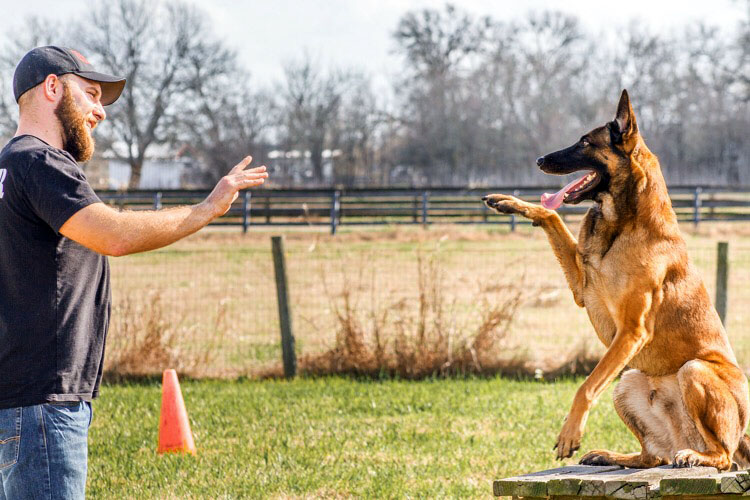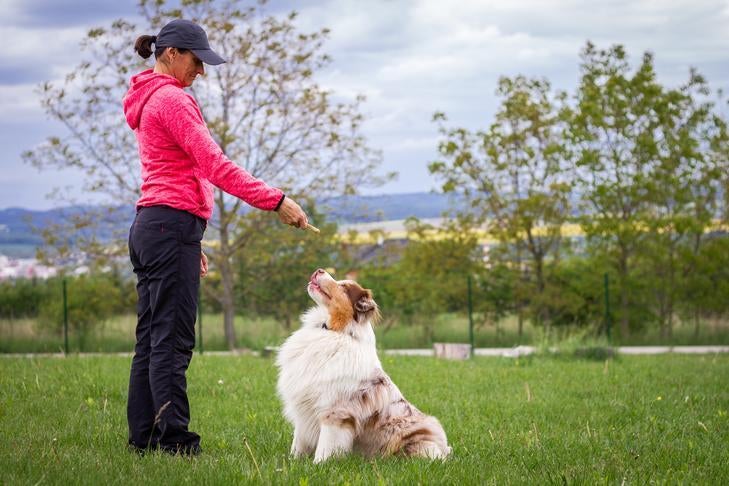Essential Tips for Successful Dog Training: A Guide for Pet Owners
Effective pet training is a diverse process that needs a tactical strategy tailored to both the pet's character and the owner's goals. Recognizing exactly how to browse these challenges can significantly improve the training experience, ultimately changing the relationship in between proprietor and canine.
Recognizing Dog Actions
Recognizing dog behavior is necessary for reliable training and cultivating a harmonious relationship between canines and their owners. dog training. Pet dogs interact mostly via body language, articulations, and activities, making it crucial for owners to interpret these signals accurately.

Socialization plays a considerable duty in pet dog habits; exposure to various settings, individuals, and various other animals can considerably impact a dog's personality. In addition, elements such as breed qualities and specific temperament should assist training approaches, as some types might have particular behavioral attributes that demand tailored approaches. By recognizing these aspects, proprietors can produce a supportive atmosphere that encourages favorable behavior, causing successful training end results and a deeper bond with their family pets.
Establishing Constant Commands
Efficient interaction with your canine starts with establishing regular commands. This foundational aspect of training is vital for cultivating understanding between you and your pet dog. Consistency in the commands you utilize ensures that your pet dog can accurately associate certain words or expressions with the desired habits.
When picking commands, choose clear, unique words that are very easy to say and separate from each other. Stay clear of using similar-sounding commands that may perplex your pet. Making use of "sit" and "stay" is proper, however "rest" and "struck" can lead to misconceptions.
Additionally, preserve the exact same tone and quantity for each and every command. Dogs are sensitive to vocal hints, so differing your tone can develop complication.
It is just as crucial to make sure that all relative get on the exact same page regarding the commands made use of. A united front in command usage will protect against blended signals and reinforce the learning procedure.
Positive Support Methods
The power of positive support in canine training hinges on its capability to encourage wanted habits through incentives and praise. This strategy is grounded in the concept that habits adhered to by positive results are more likely to be duplicated. By incorporating favorable reinforcement right into your training regimen, you can properly shape your pet's behavior in a positive manner.
To apply positive support, it's necessary to recognize what motivates your pet dog, whether it be treats, toys, or spoken praise. When your pet dog performs a preferred activity, such as remaining on command, promptly reward them with a treat or love. This organization between the command and the favorable end result strengthens their understanding.
It's critical to timing the rewards correctly; delivering the support within secs of the wanted behavior assists your dog make the connection (dog training). Additionally, uniformity is essential-- ensure that all relative make use of the same commands and benefit systems to avoid confusion

Progressively, you can decrease the frequency of have a peek at this website deals with as your pet finds out the behavior, transitioning to praise or periodic benefits. This approach not just cultivates a strong bond between you and your dog but likewise promotes a positive discovering setting, making educating a delightful experience for both.
Socialization and Interaction
Consistently exposing your canine to a variety of atmospheres, people, and other pets is crucial for their social advancement. Socialization ought to begin early, ideally during the crucial window of 3 to 14 weeks, when puppies are most receptive to new experiences. Older canines can also benefit from recurring socializing initiatives.
Introduce your dog to various setups, such as parks, pet-friendly shops, and urban areas. This exposure aids them adjust to different stimuli, reducing anxiousness and concern actions. Motivate positive communications with other pets and people, guaranteeing that these encounters are secure and regulated to foster self-confidence.
Use structured playdates with genteel pet dogs, as this can enhance your pet dog's social skills and show them suitable actions. Obedience classes and training sessions additionally offer superb chances for socializing, allowing your pet to communicate with others in a monitored environment.
Screen your pet's body language throughout interactions, as this will aid you gauge their convenience degree. Gradually boost direct exposure to more tough situations while making sure that each experience is favorable. A well-socialized canine is much more most likely to exhibit balanced habits, making them a pleasure to have in any setting.
Resolving Usual Training Challenges
Every pet dog owner will certainly encounter training challenges at some time, no matter their pet's age or socialization level. Determining typical concerns such as stubbornness, distractions, and fearfulness can assist in establishing reliable approaches for improvement.

Diversions throughout training sessions can thwart emphasis. To battle this, begin training in a silent setting with marginal stimulations. Slowly present diversions as the pet dog ends up being a lot more efficient in commands. Short, constant training sessions are likewise efficient in preserving attention.
Fearfulness can hinder a pet's understanding procedure. Progressive desensitization to the source of anxiety, coupled with positive reinforcement, can aid ease anxiety. Perseverance is vital; never compel a pet dog into a scenario that triggers distress, as this may aggravate the problem.
Eventually, understanding and resolving these typical challenges with an organized method will certainly promote a more effective training experience, enhancing the bond in between canine and proprietor while promoting reliable discovering.
Conclusion
In recap, successful pet dog training counts on a detailed understanding of canine behavior, the facility of consistent commands, look at here and the application of favorable support methods. Socializing plays an important duty in establishing well-adjusted pet useful link dogs, while dealing with usual training challenges needs perseverance and versatility. By applying these important methods, pet owners can cultivate a strong bond with their canines and advertise preferable habits, ultimately causing a harmonious connection between people and their canine friends.
Comprehending canine actions is important for efficient training and cultivating a harmonious relationship between dogs and their proprietors.Socializing plays a significant role in canine habits; direct exposure to numerous settings, people, and other animals can considerably affect a pet dog's personality.The power of favorable support in pet training exists in its capacity to encourage desired behaviors through rewards and appreciation. By integrating favorable support right into your training program, you can successfully form your pet dog's habits in a useful way.
In recap, successful canine training depends on an extensive understanding of canine behavior, the establishment of consistent commands, and the application of favorable support strategies.